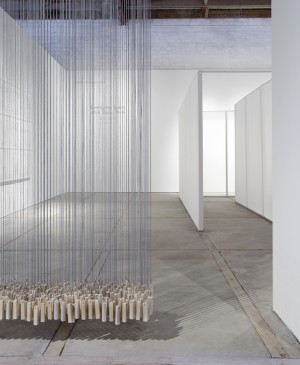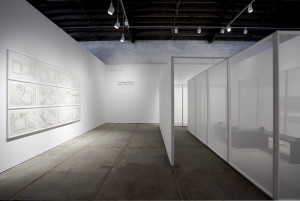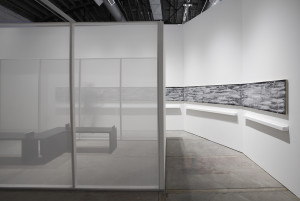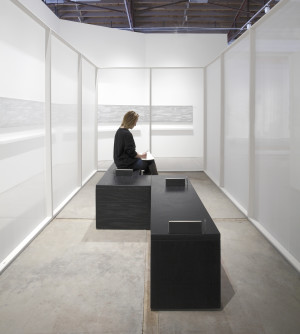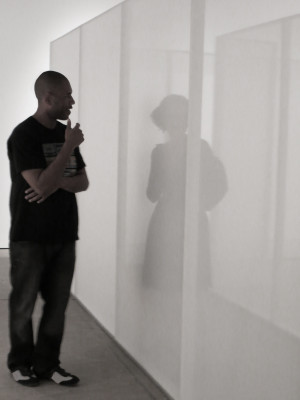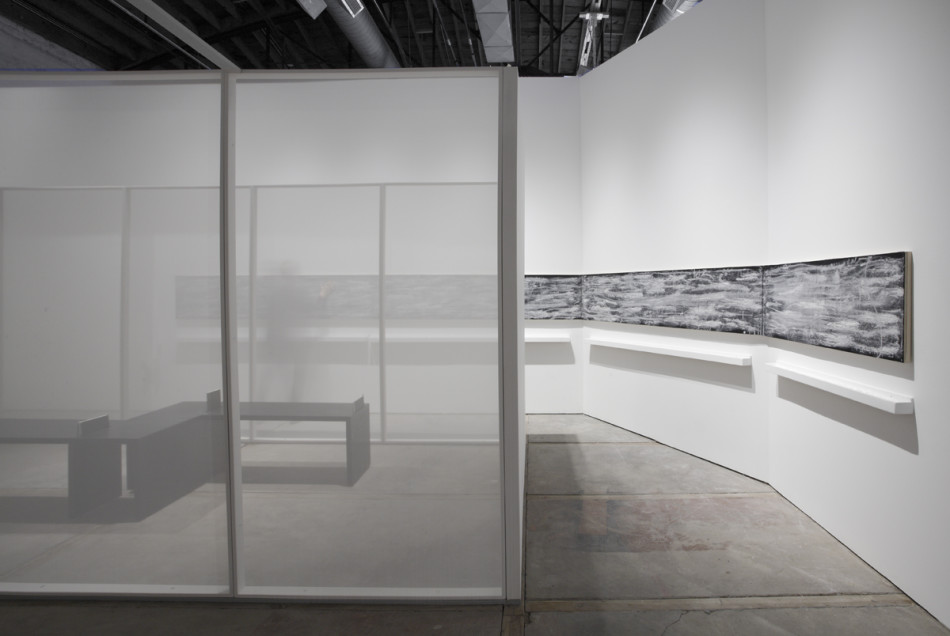
Enveloping Space included a long swath of felt on which exhibition visitors could swab a gesture in chalk with their hands. Photo: Addison Doty
A Conversation on “Enveloping Space” with Jane Lackey
Artist Jane Lackey’s Enveloping Space: Walk, Trace, Think, was at the Center for Contemporary Art from April 11 to June 1. The artist’s drawings on translucent Japanese paper were the inspiration for the ambitious installation, which consisted of four discrete works that together formed an interactive and contemplative space. Jane Lackey is contributing faculty at Santa Fe University of Art and Design.
The title is apt for the project- directing viewers to follow a path and to leave a bit of themselves there. I wonder if you felt limited in any way by the size of the project space.
No, the space is an experimental project space and it was important for me to work within the limitations. One of my goals was to make the space feel larger than it is and to place the viewer in an experience that has multiple components — almost like a meal.
That’s a great analogy, so let’s start with the “appetizer,” the curtain of strings hung from the ceiling and weighted by small wood blocks that creates the first of the translucent borders that the viewer must go around.
They can enter through either side but first they are slowed while making a transition over the threshold and into the space of the installation. The pine pieces weight the nylon cords that are suspended from rubber bands and sway with air currents. The cords are threaded into the structure above very much like the threading of a loom at a diagonal that optically creates a striped division of lines. As someone said — much like driving by rows of planted trees.
Two points that you’re making lead us to what are important element of the works — materials, which appear in different forms in the four works, and a sense of ambient movement. The drawings on the wall as you enter on the left seem to be floor plans at angles to a grid as if the spaces are floating.
When I describe the space as “enveloping” in the title, I am referring to space that is atmospheric rather than solid. Something like a mist or fog, so the choice of scrim or translucent fabric was a natural choice. It surrounds but is not obstructing.
The heart of the installation is an interior space with a specific path to follow. It seems to be a sanctum sanctorum. Describe it.
Two layers of walls made with translucent fabric that is stretched over frames are set into the grid of the floor so that you can walk between the walls and into a central space with two linked benches. Here you can simply sit and observe the layers of scrim and what the outside looks like from this position or you can just think. You also have the choice to write in notebooks that are placed in slots in the benches. I have written an introduction in the beginning of each notebook describing a type of book called a commonplace book and I invite anyone to join by writing in the books.
The benches are beautifully crafted and each holds a book and a pen, very Japanese in design. How did five months that you spent in Japan on a residency pertain to this project?
Mostly I was making the most minimal and simple choice I could with bench, notebooks and pens — just the essentials. The benches were fabricated by Thomas Lehn. Yes, I did research in Japan in 2011. I had become interested in the combination of walking and perception. My work was often referred to as circuits so I learned of the pilgrimage circuits in Japan and focused my research on the effects of walking through various temple settings and observing the sequences of paths, the accumulations of materials left along the way and the relationships of nature and built structures and the process of thinking in such an environment. Then I did drawings from the memory of what I experienced.
From within the enclosed space one glimpses the final work, a horizontal band of felt lining the wall with a narrow shelf below, containing chalk dust. This is the “trace” of the title. Viewers can use the chalk dust, correct?
The felt is black wool and nice to the touch. You can put chalk dust on your hand and rub across the surface. When many people leave a trace, there’s an accumulation of marks that builds up over time into a cloud-like field. I have always liked to move my hand along a wall and the sensation of guiding where I am walking. The felt follows the wall along a narrow path and you can enter the writing space that way or exit it. Writing in the books might take some concentration, whereas leaving a trace on the felt is purely sensation.
All of this reminds me that you worked with fabric and textiles. What is your artistic background? How did you get to Santa Fe?
Drawing and working with cloth and textiles are at the core of my practice. I came to Santa Fe to concentrate in the studio after many years that combined teaching and studio practice. Before I arrived here I was Artist-in-Residence at Cranbrook Academy of Art heading the graduate program in fiber and prior to that my studio was in Kansas City where I was Professor at Kansas City Art Institute.
I noticed that many visitors wrote in your books, appreciating the space, calling it a “refuge.” One person wrote “The world needs more spaces like this.” This resonance with viewers is especially potent because your exhibit is situated next to a very large exhibition with a lot of colorful work. Did you know that the Armory show would be concurrent with your installation?
Not until I had already started my project. My work was made in reference to our busy and packed lives. I have always made work that requires silence and time to explore. My intention was to entice people to spend time there and to feel surrounded and focused.

